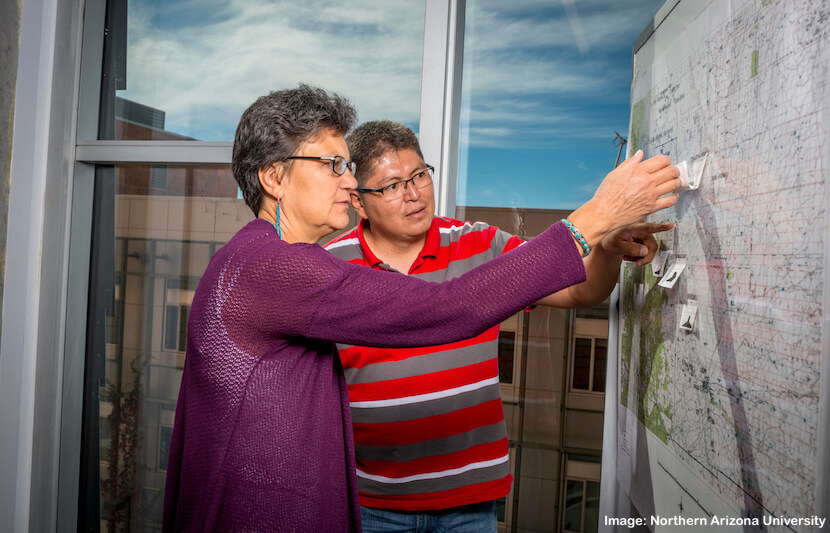In the U.S., Native Americans have the lowest university enrollment and graduation rates out of any group. And in fields of science, technology, engineering and math (STEM), they only represent 0.5 percent of students.
In an effort to combat the underrepresentation, two professors at Northern Arizona University (NAU) have received a $2.6 million grant from the National Institutes of Health (NIH), so they can create an interdisciplinary program to recruit Native American students into STEM.
The two professors leading the program are Cathy Propper, a professor in the Department of Biological Sciences, and Leslie Schulz, a professor in the Health Sciences Department.
“This funding will allow us to provide structured training at the undergraduate and graduate level for 40 students who may not have otherwise had access to STEM research opportunities,” said Propper.
The RISE program
People living on tribal lands experience a disproportionate amount of cancer, stroke, obesity, diabetes and other environmentally-associated illnesses.
In the Research Initiative for Science Enhancement (RISE) program, students will work closely with world-class researchers to study the pressing environmental issues causing these illnesses.
The program will earn participating students two years of research training in a wide-range of STEM subjects.
It is expected to enhance the diversity of workers in biomedical, behavioral and clinical research fields.
But most importantly, this program aims to encourage students to enroll in doctoral programs and to engage long-term in STEM disciplines.
“Having these students move forward in STEM careers will provide a diverse scientific workforce educated to lead environmental health-related research,” said Propper.
Students accepted into the program will first attend a summer workshop geared to emphasize community connections, culturally-aligned mentorship, scientific identity formation and value alignment.
During the academic year, students will take a course called Success in Research Seminar, which will prepare them for future STEM endeavours.
The students will study the keys to conducting responsible research and learn how to manage graduate school.
Through the class, students will learn how to analyze research results, read and interpret research literature, develop writing skills, and present results at scientific conferences.
Additionally, they will be advised to take courses in statistics, environmental sciences, health sciences, applied indigenous studies and computer science.
“This program is innovative because we are integrating culturally sensitive support, hands-on research experience and a required curriculum into a distinct and place-based theme that will generate excitement and improve success among our students,” Propper said in a statement.
Importance of diversity in STEM
STEM industries are growing extremely quickly, and strong efforts have been made to increase diversity.
“Diversity in STEM programs is important because people from diverse backgrounds provide unique perspectives that promote a broadening of viewpoints,” said Propper. “This wide angle view across a diverse group leads to the development and exploration of questions that may not otherwise be asked or investigated.”
In STEM, diversity of thought and opinion results in the best ideas and inventions. This comes from bringing people together who, culturally, may be very different.
“Encouraging students from diverse populations, who may not always see role models who come from their backgrounds, will allow us to broaden the STEM workforce and provide new career opportunities,” said Propper.
Why NAU?
NAU is a perfect fit to receive this grant because it is geographically close to the tribal lands and communities that will be studied in the program.
Students will be primarily focused on environmental issues in the Navajo Nation, Hopi tribal lands and Yavapai Apache tribal lands, but will also be able to participate in projects that their mentors are working on, all over the world.
NAU faculty are nationally recognized as experts in the field of environmental issues on tribal land, and Native American students are highly interested in the subject.
Propper and Schultz recruited a wide range of faculty members based on their expertise in research on environmental health.
“We reached across campus to recruit outstanding NAU faculty mentors to work with these students, all of whom are researchers with world-class reputations,” Schulz said in a statement.
Long-term goal
The overarching goal of this program is to provide a path for Native American students to spend their careers in STEM.
The leaders hope that the program can inspire more Native Americans to join STEM disciplines in the years to come.
“We anticipate that the students in our program will continue in STEM fields and become role models for a new student generation,” said Propper. “Having role models that come from a similar background, both culturally and educationally, encourages others to achieve their long-term vision.”
Currently, the RISE program is funded for five years, said Propper.
“But if successful, and if the funding program still exists through the NIH, we will reapply for funding through the competitive renewal process,” she continued.



